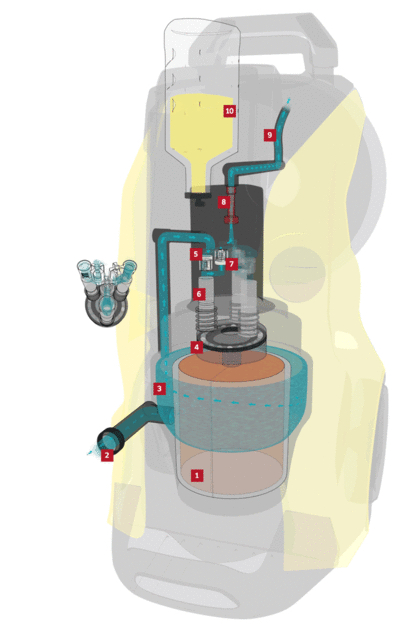
How does a pressure washer work?
Pressure washers can be used to clean practically everything on or around the house in next to no time. But how does a pressure washer actually work? Take a look inside the K 7 Full Control pressure washer.
The illustrated graphic represents the Kärcher K 7 Full Control pressure washer. Where is the motor, where does the water go once it enters the pressure washer through the garden hose, and how is the pressure created?

Example: the Kärcher K 7 Full Control
The heart of every pressure washer is its electric motor, which drives the pump system [1]. In order for the pumps to work correctly, they need water, which is provided, for example, by a garden hose [2]. Before it is put under pressure, the water flows into a double-walled casing around the motor, which cools it down [3]. This reduces noise and also extends the device’s run time.
The motor drives a wobble plate, which moves the three pistons up and down [4]. The K 7 Full Control features a total of three pistons, which each work with one suction and one pressure valve. The downward motion of the pistons [6] draws the water through a suction valve [5] and into the cylinder or piston chamber. When the piston moves up again, it pushes the water out of the piston chamber and through a pressure valve [7] towards the injector.
Cleaning agent [10] is added to the injector [8] if required. The water then flows out of the pump [9] to the high-pressure gun. The water flowing through the injector [8] creates a negative pressure which in turn causes a suction aiding the high pressure pump to supply chemical agent [10] into the water as and when needed. The water then flows out of the pump [9] to the high-pressure gun.
Of course, in real time, this all happens so fast that once you have turned on the device, you can immediately press the trigger to start cleaning. The pressure washer pictured here features an LED display on the trigger gun, which shows the pressure level selected, as well as an application example. This makes it easy to find the right setting for every application.
Apart from the outstanding cleaning performance, cleaning with a pressure washer also saves water. The average flow rate for a garden hose is around 3,500 litres an hour while a pressure washer consumes an average of 500 litres an hour depending on the model. Due to the high impact pressure and reduced water flow rate we guarantee a huge saving on time, money and effort.
Credit/Source: Kärcher, www.kaercher.com/za/inside-kaercher/newsroom/kaercher-stories/how-does-a-pressure-washer-work

Sorry, comments are closed for this post.